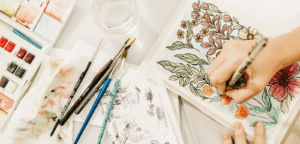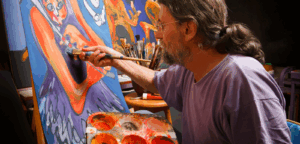Passionate about painting: why sharing your technique is essential

from Nohô
On Friday 22 November 2024 at 10:48

Passionate about painting: why sharing your technique is essential
Painting is much more than just a hobby. It’s a form of personal expression that allows you to capture unique emotions, ideas and visions. If you’re passionate about this art, you know how rewarding it can be to create something unique with your own hands. But beyond your own pleasure, there’s great value in sharing your technique and know-how with others. Whether you’re an amateur or advanced painter, teaching and sharing your art can inspire, educate and evolve the art community. In this article, we’ll find out why it’s essential to pass on your painting technique.
Promoting art and creativity
- Inspiration for others
By sharing your techniques, you can inspire others to start painting. Many aspiring artists hesitate to start for fear of failure, or because they don’t know where to begin. By showing them your methods, sharing your mistakes and successes, you can encourage them to take the plunge and develop their own style. Art is a space for exploration, and seeing an artist at work can be a revelation for those who have never dared take the plunge.
- Developing creativity
Painting, like any other art form, nurtures creativity. By sharing your technique, you open up new perspectives for those who wish to express their creativity. Every artist has a unique approach, and by teaching your own, you can help others find their own path in art. It’s also a great way of breaking down barriers and showing that creativity has no limits, whether in the choice of colors, textures or subjects.
Passing on specific techniques
- Broaden your palette of knowledge
Every artist uses different techniques, whether in the application of colors, the handling of brushes or the use of various supports. By sharing your personal methods, you can help others to diversify their practice. Perhaps you’ve developed tips on how to work faster or achieve a particular textural effect? This kind of practical advice can be a great help to beginners and more experienced artists alike.
- Preserving artistic traditions
Some painting styles and techniques, such as watercolor, oil painting or fresco, require specific skills that are passed down from generation to generation. By teaching your technique, you’re helping to preserve these skills, enabling these artistic traditions to endure. This is particularly important at a time when many traditional arts are in danger of disappearing in the face of modern technology.
Encouraging artistic exchange and development
- Encouraging exchange between artists
Art is a constantly evolving discipline, influenced by exchanges between artists. By sharing your techniques, you become part of a community that evolves thanks to everyone’s contributions. This exchange of know-how not only enhances the skills of others, but also enables you to learn new techniques yourself. Teaching is often a way of deepening your own practice and discovering new perspectives.
- Develop your own style
By teaching others, you can also develop your own style. Sharing and explaining your techniques forces you to reflect on your own approach, which can sometimes lead you to discover aspects of your art you hadn’t considered before. The questions posed by others can push you to innovate, to try new things and to step out of your comfort zone.
Raising awareness of the importance of art in society
- Promoting Art as Therapy
Painting is not only a creative activity, it can also be therapeutic. Many people use art as a means of expressing difficult emotions or relieving stress. By sharing your passion and techniques, you can help others discover this beneficial aspect of painting. By organizing workshops or creating online tutorials, you can help make art more accessible and show that it’s a real source of well-being.
- Educating the public about the richness of art
Art education is an important pillar in raising awareness of the importance of art in society. By sharing your know-how, you can help reinforce this education and make art more visible in everyday life. Whether through exhibitions, workshops or interventions in schools, you play a key role in spreading art and culture.
How do you share your painting technique?
- Organize initiations with the Nohô app Offer workshops to introduce others to different painting techniques. This can be face-to-face in your studio or even online, depending on your target audience.
- Create Online Content Platforms like YouTube, Instagram or even blogs are great ways to share your tips and techniques with a wide audience. You can offer video tutorials, detailed articles or even podcasts about your practice.
- Participate in Artist Groups Join local or online artist groups where you can share your knowledge with other enthusiasts. These exchanges enrich not only others, but also you in return.
- Collaborate with schools and cultural centers Offer your services to local schools, associations or cultural centers. Teaching art from an early age can have a lasting impact on children and young adults, raising their awareness of the importance of creativity.

Sharing your passion for painting is more than just showing how to handle a brush. It’s an act that contributes to the spread of creativity, to the inspiration of others, and to the ongoing evolution of art. By passing on your techniques and know-how, you take part in a collective adventure that enriches both you and the other artists. So, whether you’re an experienced painter or a beginner, don’t hesitate to open the door of your studio and invite other enthusiasts to discover and learn from your art.

from Nohô
On Friday 22 November 2024 at 10:48
You may also be interested in these articles










